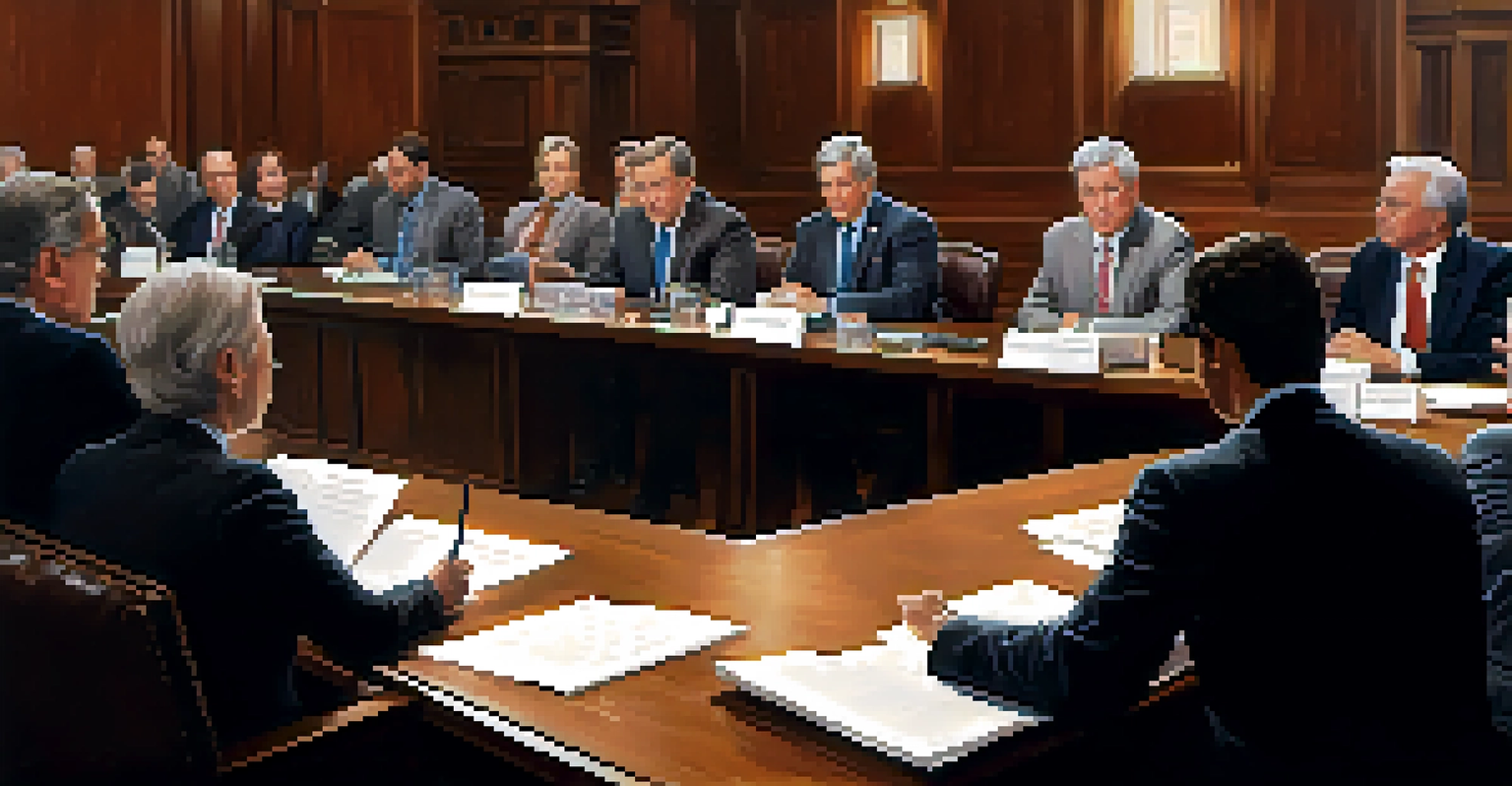The Role of the Texas Legislature in State Governance

Overview of the Texas Legislature's Structure and Functions
The Texas Legislature is a bicameral body, consisting of the House of Representatives and the Senate. With 150 members in the House and 31 in the Senate, this structure allows for a diverse representation of Texas's vast population. Each chamber has distinct roles, yet they work together to create and pass laws that govern the state.
In a democracy, the people get the government they deserve.
One of the primary functions of the Legislature is to draft and enact legislation that impacts various aspects of life in Texas, from education to healthcare. This process involves proposing bills, debating their merits, and voting on them. It's a dynamic environment where ideas can flourish or falter based on the interests of the constituents and the political landscape.
Additionally, the Legislature plays a crucial role in the state’s budgetary process. Each session, lawmakers are tasked with allocating funds to various agencies and programs, ensuring that Texas residents receive essential services. This responsibility underscores the importance of legislative decisions on everyday life.
The Legislative Process: How Bills Become Laws
Understanding how a bill becomes a law in Texas is essential to grasping the legislative process. It all begins when a legislator introduces a bill, which is then assigned to a committee for review. Committees play a vital role in shaping legislation, as they can suggest amendments or even decide whether the bill should advance to the full chamber.

Once a bill passes through committee, it moves to the floor for debate among all members. This stage is where lawmakers can express their support or opposition, share personal anecdotes, and discuss the potential impact of the legislation. The debates can be passionate, reflecting the values and concerns of their constituents.
Texas Legislature's Structure Explained
The Texas Legislature is a bicameral body consisting of the House of Representatives and the Senate, working together to draft and enact laws that affect the state's residents.
If a bill successfully passes both chambers, it is sent to the governor for approval. The governor can sign the bill into law, allow it to become law without a signature, or veto it. This final step highlights the checks and balances inherent in Texas's governance structure, ensuring that no single entity holds absolute power.
Key Roles of State Representatives and Senators
State representatives and senators have distinct roles, yet they share a common goal: to serve their constituents. Representatives typically focus on local issues, bringing the concerns of their district to the forefront of legislative discussions. They often engage directly with community members to understand their needs and advocate for relevant policies.
Legislation is the art of compromise.
On the other hand, senators, representing larger districts, tend to address broader issues that impact the state as a whole. Their role often involves building coalitions and fostering relationships with various stakeholders to push forward significant legislative initiatives. This collaborative approach can lead to more comprehensive solutions that benefit all Texans.
Both roles require a deep understanding of state governance, as well as the ability to communicate effectively with the public. Successful legislators are those who can bridge the gap between government and constituents, ensuring that the voices of Texans are heard and represented in the Capitol.
The Importance of Committees in the Legislative Process
Committees are often referred to as the backbone of the legislative process in Texas. They are responsible for conducting hearings, gathering information, and scrutinizing proposed legislation. This in-depth examination helps ensure that only well-considered bills move forward, which ultimately enhances the quality of laws passed.
Each committee focuses on specific areas, such as education, health, or transportation, allowing members to become experts in their fields. This specialization means that when a bill reaches the committee stage, it benefits from the collective knowledge and insights of its members, leading to more informed decision-making.
Legislative Process of Bills
Bills in Texas undergo a detailed process involving introduction, committee review, and floor debate before reaching the governor for approval or veto.
Moreover, committees serve as a platform for public input, where citizens can voice their opinions on pending legislation. This engagement is vital for a democratic process, as it promotes transparency and accountability, ensuring that lawmakers remain connected to the needs of their communities.
The Role of the Texas Governor in Legislative Affairs
The Texas governor plays a pivotal role in the legislative process, acting as both a leader and a check on legislative power. With the authority to veto legislation, the governor has significant influence over which bills ultimately become law. This power can shape the legislative agenda and guide lawmakers in their decision-making.
In addition to vetoing bills, the governor has the ability to call special sessions of the Legislature, which can focus on urgent issues or unfinished business. This strategic tool allows the governor to prioritize specific policies and rally support for their initiatives, further emphasizing the interconnectedness of the executive and legislative branches.
The governor’s role extends to advocating for certain legislation, often using the state of the state address to outline priorities. By communicating their vision for Texas, the governor can inspire lawmakers to take action on critical issues, fostering collaboration between the two branches of government.
Engaging the Public: How Texans Can Influence Legislation
Public engagement is a cornerstone of Texas democracy, and citizens have numerous ways to influence legislation. One of the most direct methods is through contacting their state representatives or senators. Whether it’s via email, phone calls, or social media, lawmakers appreciate hearing from their constituents about the issues that matter most to them.
Attending town hall meetings is another effective way for Texans to voice their opinions. These gatherings allow residents to connect with their elected officials, ask questions, and express concerns directly. By participating in these discussions, citizens can help shape the legislative agenda and ensure their voices are heard in the decision-making process.
Public Engagement is Key
Texans can influence legislation through direct communication with their representatives, attending town hall meetings, and participating in advocacy efforts.
Moreover, advocacy groups and non-profits often organize campaigns to raise awareness about specific issues. These organizations play a crucial role in mobilizing public support, providing resources, and educating citizens on how to navigate the legislative process. With collective action, Texans can make a significant impact on state governance.
Challenges Facing the Texas Legislature Today
The Texas Legislature faces several challenges that can impact its effectiveness in governance. One major issue is the growing political polarization, which can lead to gridlock and hinder the passage of important legislation. When lawmakers are deeply divided along party lines, finding common ground becomes increasingly difficult.
Additionally, the sheer size and diversity of Texas present unique challenges. With a rapidly growing population representing various cultures and interests, legislators must balance competing priorities while ensuring that all voices are considered. This complexity requires a delicate approach to policymaking that addresses the needs of all Texans.

Finally, the increasing influence of special interest groups can complicate the legislative process. While these groups can provide valuable insights and resources, they can also lead to concerns about transparency and accountability. Striking a balance between the interests of constituents and external influences remains a critical challenge for the Texas Legislature.